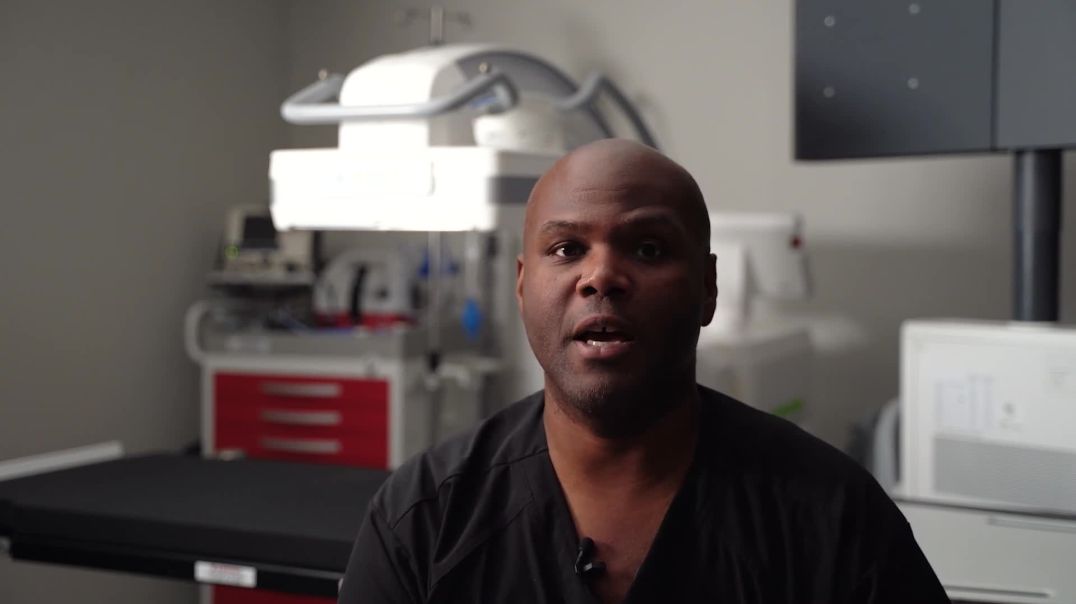Latest videos
Are you tired of struggling to understand what diabetic retinopathy is and how it affects your vision? This video is for you.
Diabetic retinopathy is a potentially sight-threatening condition that affects individuals with diabetes. It occurs when high blood sugar levels damage the blood vessels in the retina, the light-sensitive tissue at the back of the eye.
In the early stages, called nonproliferative retinopathy, the blood vessels in the retina may leak fluid or small amounts of blood, leading to swelling and distortion of vision. As the condition progresses to proliferative retinopathy, new blood vessels start to grow on the retina's surface. These new vessels are fragile and prone to bleeding, which can cause significant vision loss if left untreated.
But fear not, for knowledge is power! We will guide you through the diagnostic process, discussing the essential tests and examinations used to diagnose diabetic retinopathy accurately.
Also, our video is packed with practical tips and preventive measures to keep your eyes sparkling bright. You will learn about innovative treatments and cutting-edge technologies that are revolutionising the field of ophthalmology.
Don't let Diabetic Retinopathy cast a shadow on your future! Watch this informative video till the end and empower yourself with knowledge, ensuring a bright future for your eyesight. Remember, seeing is believing!
#diabeticretinopathy #eyespecialist #eyesondiabetes #healthyliving
--------------------------------------------------------------------------------------------------------------------
About Dr Anisha Gupta
Dr Anisha Gupta is a qualified and expert ophthalmologist in Delhi, with extensive expertise in several modern techniques, such as:
✅ Suture-less cataract surgery – both micro-incision surgery and phacoemulsification
✅ LASIK and other refractive procedures
✅ Surgical and medical vitreoretinal procedures
✅ Paediatric procedures
Her comprehensive portfolio allows her to perform efficient and effective procedures tailored to every patient’s needs. She ensures reliable results with a rich educational background serving as the foundation for her professional journey.
Schedule a consultation today -
✅ www.dranishagupta.com
✅ +91 9953040808 I 9868-040-808
✅ dranishasgupta@gmail.com
Bimat 0.03% is a revolutionary eye drop that successfully controls glaucoma and ocular hypertension and stimulates eyelash growth. Designed to lower intraocular pressure, Bimat lowers intraocular pressure by enhancing the drainage of fluid out of the eye to help save your vision and maintain eye health. Used regularly, you can experience significant improvements and live free of concern about high eye pressure.You can buy BIMAT 0.03% bottle online cheap on trusted sources. But wait, there's more! Bimat 0.03% is also famous for causing fuller, darker, and longer eyelashes. The active ingredient excites the hair follicles, thus promoting the growth of new lashes and totally transforming your looks without any trouble. Most of the customers have noticed significant improvements, and Bimat is therefore a must-have in everyone's beauty arsenal. With its ease of use and twofold benefit, Bimat 0.03% is the best choice for therapeutic as well as cosmetic effects. Consult your eye care professional how Bimat can provide you with healthier eyes and beautiful lashes.Buy bimat 0.03% online at our web store https://www.firstchoicemedss.c....om/bimat-0-03-bimato
Almox 500mg can become your best partner in upholding optimum health and well-being.This premium supplement is thoughtfully developed to enhance your immune system, boost your energy levels, and enhance overall vitality. Packed with premium vitamins and minerals, Almox 500 helps your body combat daily stressors, leaving you feeling your best each day. Whether you're dealing with a busy career, regular gym sessions, or just keeping up with your daily routine, Almox 500 provides the basic nutrients your body needs to function optimally. You can buy Almox 500mg tablets online in Australia.Made with selected ingredients for maximum absorbability and bioavailability, the supplement is perfect for anyone looking to enhance general wellness. You can sense the noticeable surge of energy and strength with Almox 500, which may empower you to take on challenges head-on. Thousands of satisfied customers already benefit from improved everyday activity by creating space for Almox 500 in their life, and now you can too! Take the well-informed choice yourself and see just how amazing Almox 500 is—your body will thank you for it.Buy Almox 500mg online at our web store https://www.firstchoicemedss.com/almox-500mg.html
It's one of the great alternatives that ignites passion and confidence with better performance improvement and unmatched satisfaction of males. Extremely careful attention to even the smallest details leads to a highly effective product utilizing sildenafil citrate, a well-established, highly regarded and trusted chemical for erectile dysfunction treatment. By offering the perfect amount of the medicine, Cobra 120mg ensures that the user is able to achieve a powerful, long-lasting erection, allowing him to indulge in intimate encounters with his partner without hesitation or restraint. The most impressive aspect of Cobra 120 mg is its phenomenal fast working capability. Within a matter of minutes after taking the pill, the users experience an increase in power and masculinity that not only enhances their self-confidence but also enhances their performance. Not only does Cobra 120mg offer unparalleled performance benefits but also safety and reliability. Subjected to rigorous quality control, the product is produced to give peace of mind to consumers, allowing them the opportunity to live in the moment, free from distraction.Buy Cobra 120mg online at our web store https://www.firstchoicemedss.com/cobra-120mg.html
Kamagra Oral Jelly 100mg has been utilized for the treatment of male erectile dysfunction. Kamagra Oral Jelly 100mg includes Sildenafil Citrate, a very effective known sensual performance-enhancing medication. Kamagra oral jelly is a specific type of drug since it is designed to be ingested orally, hence the product is able to dissolve slowly in the blood.You can buy Kamagra 100mg Oral Jelly online in Australia.Likely most among the benefits that render Kamagra Oral Jelly more convenient is the ease of use. It does not entail swallowing oral administration of other erectile dysfunction products with water; instead, one can put a small amount into their mouth by squeezing out the jelly from its sachet. This makes it the ideal option for men who have difficulty swallowing pills or for people who require a fast and discreet way of boosting their sensual performance. Another advantage of Kamagra Oral Jelly is that it works.The medicine produces its effect by soothing the blood vessels of the male genitals, encouraging increased blood flow and harder erection. Overall, Kamagra Oral Jelly is relatively safe and effective way of treating erotic sickness that has the potential to improve the erotical health and confidence of men.Buy Kamagra 100mg Oral Jelly online at our web store https://www.firstchoicemedss.c....om/kamagra-oral-jell
People who have undergone liposuction or are contemplating the surgery often ask the question - are liposuction results permanent?
In this video as we talk about the science behind the liposuction procedure and its long-lasting results, which are primarily based on fat cells and how they affect our body. Also, we are discuss the importance of a healthy lifestyle to maintain the liposuction surgery results.
If you want to know any scientific facts about liposuction or any other surgery, feel free to reach out to us.
Related Videos
Should I Opt for Liposuction or Another Approach for Loose Skin ? https://youtu.be/ypGCu512USI
What are modern tools of Liposuction ? https://www.youtube.com/watch?v=kiE9Kl8Upao&t=238s
#liposuctionexplained #permanentfatloss #liposcience #bodycontouring #surgicalfatremoval
-----------------------------------------------------------------------------------------------------
About Dr. Rajat Gupta and RG Aesthetics
At RG Aesthetics, India’s best plastic surgeon, Dr. Rajat Gupta is at your service! With 13 years of experience, brand certification, and international recognition, Dr. Gupta is the solution to all your contouring needs.
His expertise in liposuction techniques combined with the state-of-the-art technology available at RG Aesthetics ensures we continue providing the most reliable services with incredible, instantaneous results!
Our equipment allows for every kind of liposuction there is – especially the minimally invasive kinds. Dr. Gupta reflects RG Aesthetics’ belief of the patient’s comfort always being paramount. Procedures at RG Aesthetics, under Dr. Rajat Gupta, minimize trauma and speed up recovery time for the best results!
Sildalist Strong 140mg is a pharma medicine prescribed predominantly for male erectile dysfunction (ED).Sildalist Strong 140mg is produced by mixing two effective active substances, sildenafil and tadalafil, which together stimulate enhanced blood supply to the male sensual organ. With the improved blood flow, there is a harder and longer erection.You can buy Sildalist Strong 140mg online in California. Sildalist Strong 140mg also enjoys the significant benefit of strength. The higher concentration of the active ingredients makes it stronger, especially for those who have not been content with lower doses or other ED products. Furthermore, the synergy of tadalafil and sildenafil introduces a unique benefit over other ED products. This combination provides an extended duration of activity and more personalized reaction to the product, reacting to the individual needs of every patient. Another advantage of Sildalist Strong 140 mg is that it is easy to use. It comes in tablet form and can be taken discreetly without injections or other intrusive means. This feature is especially helpful for men who are shy about their ED or have an issue with other modes of treatment. In short, Sildalist Strong 140 mg is a suitable method of treatment for men with ED.Buy Sildalist Strong 140mg online at our web store https://www.firstchoicemedss.c....om/sildalist-strong-
Have you heard about eye injections? Yes, injections can be given inside the eye, and they help treat many retina problems that were previously untreatable. In this video, we talk about everything about intravitreal eye injections—how they work, when they are needed, and what to expect. If you or a loved one has been advised to get eye injections, this video will clear all your doubts.
What’s Covered in this Video?
✅ What are intravitreal eye injections, and how do they work
✅ Conditions that require eye injections (Diabetic Retinopathy, Macular Degeneration, Retinal Swelling, and more)
✅ The procedure – How the injection is given inside the eye
✅ Pain level – Does it hurt? How does it feel
✅ Side effects and risks – Are eye injections safe
✅ Types of eye injections – Anti-VEGF, Steroid injections, and Antibiotic injections
✅ Who should avoid eye injections – Conditions where they are not recommended
✅ Precautions and aftercare – What to do before and after the injection
✅ Cost of eye injections – How much do they cost in India
If you are worried about getting an eye injection, don’t be. These are safe, effective, and painless treatments that help save vision. Watch this video to understand how eye injections work and why they are essential for many eye conditions.
Have any questions? Drop them in the comments.
-----------------------------------------------------------------------------------------------------------------
About Dr Anisha Gupta
Dr Anisha Gupta is a qualified and expert ophthalmologist in Delhi, with extensive expertise in several modern techniques, such as:
✅ Suture-less cataract surgery – both micro-incision surgery and phacoemulsification
✅ LASIK and other refractive procedures
✅ Surgical and medical vitreoretinal procedures
✅ Paediatric procedures
Her comprehensive portfolio allows her to perform efficient and effective procedures tailored to every patient’s needs. She ensures reliable results with a rich educational background serving as the foundation for her professional journey.
Schedule a consultation today -
✅ https://www.dranishagupta.com
✅ +91 9953040808 I 9868-040-808
✅ dranishasgupta@gmail.com
✅https://www.instagram.com/dr_anishasgupta/
✅https://www.facebook.com/DrAnishaSGupta/
#eyeinjection #retinatreatment #diabeticretinopathy #maculardegeneration #intravitrealinjection #eyecare #visionhealth #retinadoctor #diabetesandeyes #eyespecialist #ophthalmology #antivegf #eyehealthawareness #dranishagupta #eyedoctorindia #exceleye #excelhispital #dranishagupta
Vidalista Black 80mg is a very well-known male ED pill, particularly 80mg.The active component tadalafil of the product causes an erective hard and long-lasting erection in a man as there occurs an increase in the movement of blood into the genital organ.You can buy Vidalista 80 mg tablets online. There are many reasons why one should take this Vidalista Black 80 mg since it is one of the most effective ED products. It makes it possible for the male to engage in sensual activities as and when he desires since studies have proved that it helps them to achieve and sustain erection for up to 36 hours.It is also simple to use Vidalista Black 80 mg.The dosage is one tablet orally with water once a day. It comes in the form of tablets. To achieve the maximum effects, you must take the medication as directed by your physician. Vidalista Black 80mg is a highly safe and efficient medication in ED treatment. Buy Vidalista Black 80mg online at our web store https://www.firstchoicemedss.c....om/tadala-black-80mg
The prescription medication Snovitra Professional 20mg is taken to cure male impotence in patients. Vardenafil (20mg) is the active ingredient mainly used in this medication and is meant to cure ed issues.Impotence or erectile dysfunction is a condition where the male is not able to get a hard enough erection for sensual activity.This leads to disappointing results in the sensuous activity, which doesn't make you and your partner satisfied. You can buy Snovitra Professional 20mg tablets online. Having an ed issue also creates other problems like low self-confidence, insecurities, etc.This product helps to increase blood flow to the male genital organ, helping in gaining a firm erection sufficient for sensual activity.This product should be taken 30 to 60 minutes prior to sensual activity, with a glass of water.This product should not be chewed or crushed into small pieces.People suffering from ed can greatly benefit from this product, but you should thoroughly consult with your doctor or other healthcare provider before taking it.You shouldn't have any kind of ingredient's allergy in order to consume the product. You must not be consuming nitrates too.Buy Snovitra Professional 20mg online at our web store https://www.firstchoicemedss.c....om/snovitra-professi
Precision Vascular Kentucky specializes in innovative treatments for peripheral arterial disease (PAD), uterine fibroids, and debilitating joint pain affecting hips, knees, and shoulders. Led by Dr. Jean-Baptiste in Louisville, we are dedicated to "Restoring Flow! Saving Limbs! Changing Lives!" through advanced interventional procedures. We excel in treating PAD-related leg and foot pain, particularly for diabetic patients over 50 with non-healing wounds who may face amputation recommendations. Our expertise includes limb salvage through procedures like angioplasty and angiograms. For women suffering from uterine fibroids causing heavy bleeding and pelvic pressure, we offer uterine fibroid embolization (UFE) as an alternative to hysterectomy. Our joint pain treatments, including genicular artery embolization (GAE), provide hope for patients told they're too young for knee or hip replacement. We treat pain and stiffness through minimally invasive procedures that can eliminate what patients describe as "suicide pain." Precision Vascular Kentucky serves Louisville, Kentucky and Southern Indiana, working with multiple insurance providers. Our patient-centered approach combines cutting-edge endovascular treatments with compassionate care, helping patients achieve pain-free movement and improved quality of life when traditional alternatives may not be effective. For more info, visit us at https://precisionvascularkentucky.com/blog/ and https://precisionvascularkentu....cky.com/peripheral-a
Phone: (502) 365-4151
Address: 512 Executive Park, Louisville, KY, 40207, USA
Are the cosmetic surgery terms such as liposuction, liposculpture and hi-def liposuction confusing to you? What are these technologies?
This video opens up new horizons on liposuction procedures and their technological advancements in terms of lipo-sculpting and high-definition procedures that are helping many patients get their desired body shape.
Watch this video to know more.
#liposuction #liposculpture #highdefinitionliposuction #3dliposuction #4Dliposuction
-----------------------------------------------------------------------------------------------------
About Dr. Rajat Gupta and RG Aesthetics
At RG Aesthetics, India’s best plastic surgeon, Dr. Rajat Gupta is at your service! With 13 years of experience, brand certification, and international recognition, Dr. Gupta is the solution to all your contouring needs.
His expertise in liposuction techniques combined with the state-of-the-art technology available at RG Aesthetics ensures we continue providing the most reliable services with incredible, instantaneous results!
Our equipment allows for every kind of liposuction there is – especially the minimally invasive kinds. Dr. Gupta reflects RG Aesthetics’ belief of the patient’s comfort always being paramount. Procedures at RG Aesthetics, under Dr. Rajat Gupta, minimize trauma and speed up recovery time for the best results!
When it comes from mild to moderate pain can be cured using Tydol 100mg. The main active constituent in the composition of this medication is 100mg of tapentadol.You are advised to consult your physician before using this prescription medication.You can buy Tydol 100 mg tablets online. Through its action on opioid receptors, tapentadol mostly works on the neuron system by suppressing proper neuronal function and the ability of the body to warn the brain of pain. This makes us feel that there is no pain at the moment. You need to consult your doctor before you use this if you have a serious sickness or disease, as failure to do this can expose you. Tydol is a great painkiller that does wonders. This is not something you chew or cut; this is something you swallow whole with water. This really alleviates your pain and improves your way of life.This is not utilized for common diseases like a minor headache. It's also something to mention that you simply can't be allergic to the ingredient in the product.Buy tydol 100mg online at our web store https://www.firstchoicemedss.c....om/tapentadol-100mg.
Fildena 50mg is one of the great products present in the market for the cure or treatment of impotence among men.The active ingredient employed in this product is called Sildenafil citrate (50mg).So, Fildena 50mg will provide you with a wonderful substitute for treating your ED. Fildena 50 mg has a soft dose of the drug, Sildenafil is FDA-approved so it is safer for your use.The product increases blood supply to the genital organ of the men, and hence erection becomes stiffer.You can buy Fildena 50 mg purple pill online. It is one of the very common issues these days, so there would be no hesitation in front of your doctor for a consultation. One more thing you have to do is tell your medical history to your doctor so that he can investigate if this medicine is good or bad for you. Sometimes we are allergic to something, and we do not know about it. So it's extremely crucial to verify if you are or you are not allergic to the ingredient found in the product. Fildena revives your lost confidence once more and makes you regain that by bringing more easiness in your sensual life, and it is even a happiness giver to both you and your partner.This is one hell of a decision if you are facing the problem of ED.Buy Fildena 50mg online at our web store https://www.firstchoicemedss.com/fildena-50mg.html
If you are looking for the treatment of premature ejaculation (PE) then there is a highly effective product called poxet 60mg.Millions of men suffer from PE, a frequent sensual dysfunction characterized by a persistent or recurrent inability to delay ejaculation on sensual stimulation.You can buy Poxet 60mg tablets online.The active substance of the product is Dapoxetine, an SSRI (selective serotonin reuptake inhibitor). Dapoxetine delays ejaculation by raising the level of serotonin in the brain, that's how it works. It is not meant to be taken every day like medication. Take as needed, 1 to 3 hours prior to sensual play. No more than a single tablet is to be taken within a 24-hour period. It is worth visiting your doctor prior to taking this product. To find out if this is appropriate and safe for you, your doctor will examine any existing health condition that you may have as well as any other medications that you may be using. Additionally, you should report promptly to your physician in the event of unusual symptoms experienced by you when on Poxet 60mg.Buy Poxet 60mg online at our web store https://www.firstchoicemedss.com/poxet-60mg.html
A great product that has helped numerous individuals enjoy more sensual fulfillment and pleasure is Kamini Oral Jelly. It is a premium product that is created to enhance sensuous function in men and women and has been found helpful by various satisfied customers. You can buy Kamini 100mg oral jelly online in Australia. Kamini Oral Jelly's quick-acting formula, through which customers feel the needed effects within a very short period of time, is one of its key benefits. It is thus an excellent choice for individuals seeking an effective and reliable means of addressing their sensual problems.Kamini Oral Jelly's ease of application is another excellent advantage. Compared to other therapy designed for sensual arousal, which requires complex processes or difficult regimens, Kamini Oral Jelly is very convenient to use. Simply consume the jelly before indulging in sensual activities and enjoy the advantages. Moreover, Kamini Oral Jelly consists of organic components, making it distinct from other chemical-based products available today as a safe and healthy alternative. This means that consumers will not need to fear from dangerous side effects or harmful effects on their health in order to avail themselves of Kamini Oral Jelly's benefits.Buy Kamini 100mg oral jelly online at our web store https://www.firstchoicemedss.c....om/buy-kamini-oral-j
Vidalista 20mg is the most precise solution for all the individuals seeking a thrilling and fulfilling love life. Designed with precision, Vidalista 20mg brings the most tried and tested formula to give a new boost to your love-making life and improve your confidence. With one tablet, you can enter a world of stronger erections, and you and your partner will enjoy the pleasure of intimacy without any hesitation. You can buy Vidalista 20 mg tablets online.Vidalista 20mg is carefully crafted to increase blood supply to the critical zones, leading to increased stamina and elevated pleasure, all in the safety and comfort of your well-being. Bidding adieu to uncertainty and introducing a new sense of confidence, explore the horizons of intimacy. Vidalista 20mg empowers you to take charge of your love life, building better relationships and re-igniting the flame that makes the relationship sparkle. Believe in the science-supported efficacy of Vidalista 20mg to make your love moments into a lifetime experience.Buy Vidalista 20mg online at our web store https://www.firstchoicemedss.c....om/vidalista-20mg-ta
Women experience unwanted changes in the size, shape, and position of their breasts over time due to certain life events. Fortunately, cosmetic surgery offers women the often life-changing opportunity to restore or achieve their figure through breast augmentation, breast lift, and other complementary procedures. With the multitude of treatment options available, it can often be difficult for patients to determine which procedure may be best suited to their individual needs, whether its breast augmentation or breast lifting. Let us understand the difference between Breast Lift and Breast Augmentation.
Breast lift is known as mastopexy surgery whereas breast augmentation is a mastopexy augmentation. Some women require breast augmentation and some need breast lifting. There are some who might need both breast lifting and breast augmentation. But it's confusing for patients to opt for these procedures.
Breast Augmentation In Sagging Breast Vs Normal Breast
There might be many issues regarding the size and shape of the female breasts. Let us understand what are their issues and what type of surgery they should opt for.
1. Breast Sagging
Causes of Breast sagging
- Post pregnancy
-Weight Loss
-Heavy size of the breast
Breast sagging can be corrected with the Breast Lift Surgery or Mastopexy. Breast lift surgery is designed specifically to improve the position of the breasts. Mastopexy removes and tightens excess tissue and repositions the nipple and areola to raise sagging breasts. In this surgery size of the breast is not changed.
2. Small breasts
Causes of Small Breast
-Post pregnancy
-Breast development at puberty.
If any woman has, small breast size then Breast Augmentation Surgery is performed in order to increase breast size.
Two types of Breast Augmentation Procedure
-Implants
-Fat Transfer
3. Breast sagging + Small Breasts
Mastopexy Augmentation Surgery is performed in this case as the breasts are lifted as well as their size is increased.
Patients should keep in mind that breast sagging does not require breast augmentation procedure as it will in turn lead to more sagging due to more fats.
The patients who want to undergo both the surgeries, of Breast Augmentation and Breast lifting, should discuss with their doctor whether they want to go for both the surgeries at the same time or maybe do it one by one.
All these three procedures are different, all three surgeries are done in a different way Also the scars are different for all three. The technique used during surgery is the lollipop scar technique.
A woman suffering from sagging need to undergo breast lifting surgery, a woman with small breast need to undergo breast augmentation and woman who has sagging breast, as well as small breast, need to undergo Mastopexy Augmentation Surgery.
_______________________________________
About Dr Rajat Gupta and RG Aesthetics
At RG Aesthetics, India’s best plastic surgeon, Dr Rajat Gupta is at your service! With 10 years of experience, brand-certification and international recognition, Dr Gupta is the solution to all your contouring needs.
His expertise in liposuction techniques combined with the state-of-the-art technology available at RG Aesthetics ensures we continue providing the most reliable services with incredible, instantaneous results!
Our equipment allows for every kind of liposuction there is – especially the minimal invasive kinds. Dr Gupta reflects RG Aesthetics’ belief of the patient’s comfort always being paramount. Procedures at RG Aesthetics, under Dr Rajat Gupta, minimize trauma and speed up recovery time for the best results!
For more information please visit our website: https://www.drrajatgupta.com/
For more details,
contact us:+91-9251-711-711 or contact@drrajatgupta.com
#breastlifting #breastaugmentation #plasticsurgeon #drrajatgupta
Anaconda 120mg is the ultimate solution for making your vigor even greater and enhancing your sensual moments to a new dimension. Designed specifically with the finest ingredients, Anaconda 120mg is formulated to provide you with an extreme kick so that you can take the best out of yourself and feel thoroughly satisfied. You can buy Anaconda 120mg cheap online.Tap into Anaconda 120 mg's potency and allow its incredible attributes to elevate your sensual journey. Take one capsule and experience an unparalleled surge of energy, drive, and endurance that will leave your partner and you speechless. Anaconda 120 mg is specifically crafted to boost blood circulation to the key areas, producing harder, longer erections. Anaconda 120 mg is different from other products because of its commitment to your health and safety. Each capsule undergoes rigorous quality control processes and production in state-of-the-art facilities, so you can be sure of a trusted and reliable product.Worry not, Anaconda 120mg is produced using just the finest ingredients which have been selected by science to provide you with your best sensual encounters.BuyAnaconda 120mg online at our web store https://www.firstchoicemedss.com/anaconda-120.html
Azee 250mg is a rescuer towards the end when it is about to fight bacterial infection. Filled with convenience, Azee 250 mg is an excellent product. Right from the respiratory tract infection to the skin infection, and also other bacterial ailments, Azee 250 mg is there to provide you with speed relief and put you on your two feet. You can buy Azee 250mg tablets online. Even though it is Azithromycin as its strong active component, with every tablet of Azee 250mg performing round-the-clock action against harmful bacteria as well as growth inhibition, this broad-spectrum antibiotic has an extended spectrum of bacterial strains to offer the widest coverage and is bound to deliver the best therapy outcome. It is the convenient dosing regimen of Azee 250 mg that differentiates it from the rest. Convenience in Azee 250 mg doesn't compromise efficiency-the every tablet has the optimal dose needed to defeat infection. The medicine is highly tolerable; hence, Azee 250 mg can be prescribed even to the general population, right from adult to child. Well-tolerated formulation of Azee eliminates side effects and allows one to carry on with all day-to-day activities without any break.Buy Azee 250mg online at our web store https://www.firstchoicemedss.com/azee-250-mg.html




















